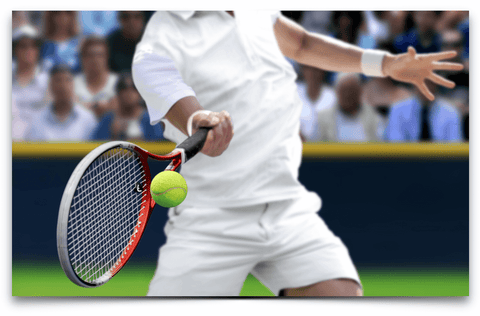"No guts, no glory"
Can you relate to these phrases? "No guts, no glory," or "Show me a good loser, and I'll show you a loser." We've all heard sayings like these to describe the attitude needed to succeed in sports.
The expression "No guts, no glory" can be traced to USAF Major General Frederick Blessed, who wrote a manual about air-to-air combat in 1955. It means success is not possible unless one takes risks. The phrase "Show me a good loser, and I'll show you a loser" came from the famous 1960s NFL coach Vince Lombardi. It's supposed to imply that losing should be seen as unacceptable and make the vanquished determined to never let it happen again.
Don't get me wrong. I love a good motivational mnemonic. However, there may be more to excelling than exhorting these catchphrases. Let's look at some not-so-intuitive ways to reach your full potential in your sport. I'll call these "traps to avoid in reaching your highest skill level":
- UNDERSTAND YOUR "WHY"
- THE PATH OF LEAST RESISTANCE
- EMBRACE REAL TRAINING
- SEEK OUT DESTROYERS
In most sports, it is accepted that a successful player must outwork every aspect of their competition to stay at the top. This is probably true, yet I believe there are some key elements to success that may go unnoticed or be misconstrued.
The need to produce quick results by coaches, parents or players can be unintentionally detrimental. For example, under extreme pressure from coaches or parents, junior tennis players may compete at a high level for a while, only to burn out before their careers begin. There are obvious lessons that will help avoid unfavorable outcomes and vanish talent.
UNDERSTAND YOUR "WHY"
There are benefits in finding a sport or activity that we love and feel compelled to do. The most common reasons are to have fun and keep fit. There are life lessons that can be learned through sports. Sports can create discipline and prioritization. And there's teamwork and sportsmanship.
These are ideals we are taught. But what is intrinsic and deep-rooted about the reason you play sports? Your "why" is unique to you, just like your fingerprint. No one else's will be the same.
Your "why" is the reason for doing something that propels you forward despite the opposition, challenges, and struggles. It's more than just a reason, though. It's something you connect with on an emotional level that drives you.
It's not only understanding your "why" but accepting it. Allow your "why" to be honest enough to power you through all the times you may feel like quitting (and there will be many). Ask yourself, "Is my 'why' such a burning desire that it can keep me going for years?
Each player should appreciate their own "why ." What is yours?
THE PATH OF LEAST RESISTANCE
At first blush, this phrase sounds like taking the easy way or the most expedient course rather than one of hard work and extreme effort. Most coaches would cringe at the idea of 'least resistance. Their mantra is "get out there and push, drive, and fight."
Yet, many coaches (and players) cater to a specific strength rather than developing an entire balanced skill set. They push selective repetitive training believing that one phenomenal power shot will carry their game. The player may work hard, thinking they are not taking the easy path. However, in my mind, this kind of discretionary training falls into the 'path of least resistance.'
What good is a firecracker forehand if the tennis player has a weak backhand? An opponent will quickly discover the weakness and exploit it. How often do we see up-and-coming players favor their one strength to the detriment of their full playing potential? This path creates more burnouts than stars, guaranteed.
Honing a skill is great and may get a few wins; however, honing a well-rounded plethora of skills will bring enduring accomplishment. Recognizing short-term paralyzing successes versus long-term developing careers is the paradox of the path of least resistance.

Coach's sidebar: Having a balanced game means mastering many techniques. It means having an excellent foundational strategy. And it means mastering the off-court game, including proper nutrition, hydration, strength-training, emotional/psychological self-care, recuperative sleep, and injury prevention. If you are in your sport for the long haul, you must be aware of all these.
Another way to think about the path of least resistance is by learning how your body works. The body's self-preserving software aids in its survival.
Mechanically, your body's natural tendency is to take the path of least resistance. It may mean the body believes it should conserve energy or compensate for stiffness or pain. This, in fact, could lead to dysfunctional movement patterns and further injury.
To have performance longevity, you must understand your body's natural tendencies. Maintaining optimal mobility, stability, endurance, and strength promotes the continuity of your body's autopilot to take the path to peak performance. Maintain your foundation with mastery of the fundamentals of your sport and sustain it for the rest of your athletic life.
EMBRACE REAL TRAINING
Most of us use the terms' practice' and 'training' interchangeably. Although they are similar, there are differences as well. 'Training' is learning how to do something or improve a skill, and 'practice' is applying what you've learned to become proficient.
Another difference between practice and training is the time involved. Learning to do something typically takes less time than becoming adept at it. For example, you may spend an hour with a tennis pro in a lesson on a particular skill, and within that hour, you are trained on how to do it. Getting good at it will require many hours of practice.
One of the most glaring examples separating the greats from the rest is their dedication to training and practice. Great players thrive on drills and practices with the specific purpose of conquering weaknesses.
Drills, for some, may mean monotonous and repetitive actions. Instead, look at these sessions as growth and development opportunities.
Be purposeful in your drills, and don't get duped into 'going through motions.' Simply put, practice does not make perfect. Natural growth and development are found through training changes and adaptations.
Why? Because you can be assured that your opponents are honing their skills and readying themselves for their next match with you. They are improving their weaknesses and are preparing to exploit yours.
By embracing training and drills, you can design and dedicate proper time toward eliminating vulnerabilities. After all, no one wants to compete against an opponent that doesn't have a weakness!
Another critical factor in good training is finding the right practice partners. Find someone who prefers drilling to merely keeping score. Finding peers who know how to practice, understand the purpose of drills, and have enough concentration to do them properly is imperative.
Many players today have become "play-at-its" masters of pretending. If you want proof of this theory, here are a few observations to test the seriousness of a training player:

- How often has the player been out on the court by themselves practicing serves?
- How many hours have they invested using the practice wall? Or the ball machine?
- How frequently are they on a court with a practice partner doing targeted drills with a basket of balls?
(These questions are more specific to tennis or other racquet sports. Adjust these questions for the particular sport you love.)
If the honest answers to these questions are "infrequent, rarely or never," then stop pretending. If you are a parent or coach of a young student, then stop coddling and wasting time and money. While I'm sure to ruffle some feathers, I hope to instill some uncommon sense here.
This analysis will result in more emerging champions across many sports disciplines. Not only will it propel players forward – the sport itself will grow. Pickleball is a great example of a growing sport attracting all ages and skill levels. The growth of a sport with more active participants will improve the healthspan of our country.
SEEK OUT DESTROYERS
Staying in the realm of training, learning, and growing, let's look at another avenue for improvement. That is to seek out opportunities to play competitors stronger than you. Again, this may be hard for some of you to do. It's comfortable to play and practice with those of similar abilities.
My apologies to Vince but seeking out better players flies in the face of the "show me a good loser" idiom. You must intentionally put yourself in the inevitable position of losing sometimes. This doesn't mean that you are a loser.
It does mean you are up-close-and-personal with how a better player moves, how they use their strengths, and how they mitigate their weaknesses. It magnifies the skills you need to develop. Take notes and create your manual for becoming great.
Every destroyer that rips your game apart shows you exactly how to design your drills. It takes guts to have your lunch handed to you over and over to get the glory.
This change in mentality begins the moment we decide to identify how to invest in our preparation time. The result is a change in intensity, execution, and attitude. We now have a better sense of purpose with our actions.
Your love for the sport will grow, along with the feeling of accomplishment that comes when you start seeing improvements.
Body Helix continues to learn, share, and inspire because many of our readers and customers support our efforts and help us expand. I provide these blogs because I care. I want to be a positive impact on your healthspan journey.
Learn. Share. Inspire.
Be well, my friends.
Coach Fred



